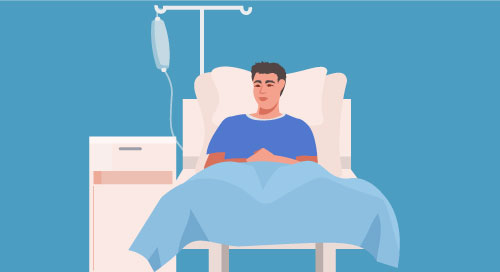Remote Monitoring: The Vision for Patient Safety

At a Connecticut hospital, one staff member simultaneously monitors a dozen patients in real time—a job that used to take 12 patient sitters. As a result, the facility reduced falls, addressed staffing shortfalls, decreased costs, and met compliance requirements. While it may sound like a case of cloning or teleportation, the New England hospital was able to transform how it delivers care by using new virtual patient observation technology.
The facility deployed the NOVA – Nursing Observation and Virtual Assistant (NOVA)—developed by national solution and service provider Wachter, Inc.—to reduce the need for patient sitters and to monitor for patient falls.
And when the pandemic hit, they were able to immediately shift and use NOVA in their fight against COVID-19.
At the time, hospitals were struggling to find PPE to protect their healthcare providers. Using NOVA, nurses could monitor patients and ventilators remotely, reducing exposure, slowing the spread of the infection, and decreasing the need to don new protective gear every time they entered an isolation patient’s room.
The solution is also in use at Montage Health. For the California-based healthcare provider, cost was a driving factor.
“They had more one-to-one sitter requests than they were able to grant, and they wanted to utilize their staff and technology to the best of their ability,” says Ashley Kuruvilla, MSN, APRN, FNP-C, Business Development Manager and Clinical Support Specialist for NOVA Health. “During the four-month period after it was initiated, NOVA reduced the number of hours for those one-to-one sitters, saving money and resources.”
Patient satisfaction improved as well, and in unique ways. “One monitor technician would sing to the patients,” says Kuruvilla. “She would talk to them and play games with them. She became an exemplary model for other technicians. One patient stated they didn’t want to leave the hospital because of her, which is remarkable.”
Health Tech Adoption
While the value of virtual observation is clear, hospitals have been traditionally slow to implement technology that can monitor patients, instead employing patient sitters, who are costly, at risk, and in high demand.
“Financial concerns are one of the issues and fear of efficacy is another,” says Kuruvilla. “There can be a lot of uncertainty and hesitancy with using technology versus an actual person. Many aren’t completely confident that technology would be able to monitor several patients at once.”
Lack of time has been another hindrance, adds Devin Johnson, National Account Manager for the NOVA team. “A lot of times the clinical staff will think, ‘This is a big project that’s going to take up a lot of my time and bandwidth,’” he says. “We’ve tried to make deployment and training as simple as possible so that the nursing staff is more inclined to embrace the change.”
But COVID accelerated the adoption of new tools, such as NOVA, as healthcare providers recognized the need for remote care options. Once in place, other valuable uses quickly surfaced.
“It can facilitate virtual rounds and physician consultation,” says Kuruvilla. “Most commonly, it’s being used anywhere a hospital would typically have a one-to-one sitter, such as Pediatric environments, the E.R., Neurological, Rehab and Behavioral Health units.”
COVID accelerated the adoption of new tools, such as NOVA, as #healthcare providers recognized the need for remote care options. @WatcherInc via @insightdottech
A Look Inside Remote Healthcare
NOVA, which is available as a mobile unit, portable wall mount, or fixed asset, uses high-definition cameras with 360-degree views as well as pan, tilt, zoom, and night vision capabilities. Two-way audio and video communication with a multi-language translation feature lets the remote caretaker communicate directly with each patient in their native language or notify nurses if aid is needed (Video 1).
The technician can visualize the room and identify any behaviors that require intervention or risk reduction, such as a patient who is pulling out tubing or trying to get out of bed. Nursing administrators can use NOVA to see how they can better improve their services.
The platform uses Intel® Core™ and Intel® Xeon® processors, which allows the solution to be scaled quickly. “Intel brings credibility right away, which makes the conversations about NOVA that much easier,” says Johnson. “We’re able to reach a broader audience as a result.”
Safety Is a Two-Way Street
While NOVA protects patients from harm, it also protects the hospital staff. “We don’t want a nurse to enter a room and not know what they’re walking into,” says Johnson. “This is primarily the case in emergency rooms as well as behavioral health units.”
The system tracks events that are performed to redirect behaviors, so the nursing staff can be sure the solution is appropriate for each individual patient. Not every patient may be a great candidate for monitoring. It can detect when someone has been redirected multiple times through NOVA’s Intervention Event Tracker. While it doesn’t predict at-risk behavior, the Sound Intelligence feature provides aggression detection analytics, such as yelling. Specific decibel levels trigger an alert, and the technician can look into the room or call security.
Being able to monitor patients 24×7 gives peace of mind to nursing staff, but it’s just the start.
“The future of virtual patient observation is the addition of more AI features, plain and simple,” Johnson says. “Any new technologies that can enhance patient care and alleviate the load placed on medical professionals will only help make the future brighter. As Wachter goes deeper into integrations, we will allow caregivers to provide a more holistic patient experience.”